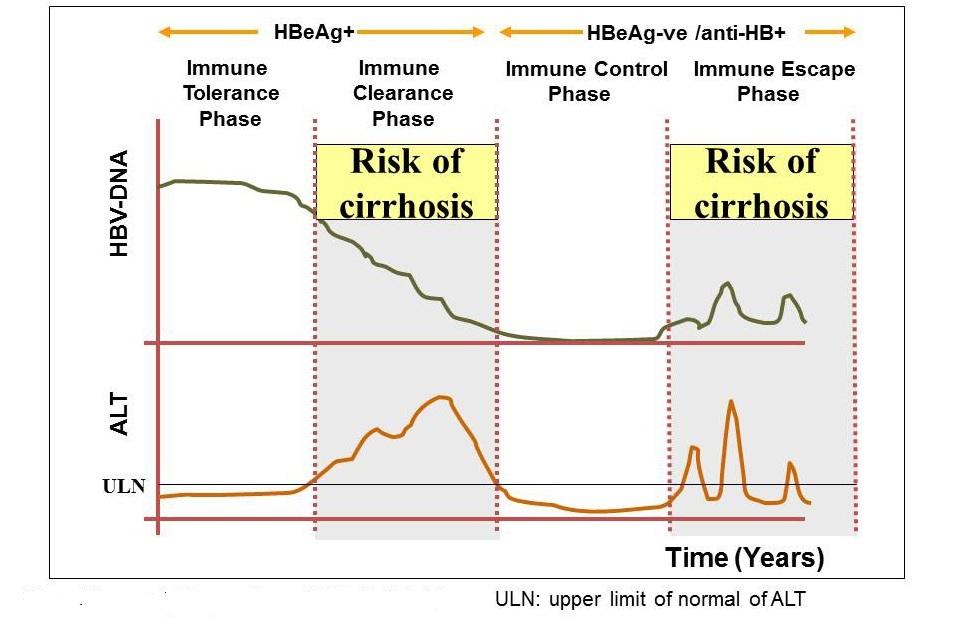HBeAg ( hepatitis B e antigen )
- hepatitis B "e" antigen (HBeAg) indicates a highly infectious state
- HBeAg appears within 1 week of HBsAg - in acute cases HBeAg disappears prior to the disappearance of HBsAg
- HBeAg is only found if HBsAg is also found
- HBeAg occurs early in disease
- generally lasts 3-6 weeks
- if HBeAg persists > 10 weeks then this suggests progression to chronic carrier state and possibly chronic hepatitis
Phases of Hepatitis B infection - relates to HbeAg and HBV DNA levels
- immune-tolerance phase
- the immune-tolerance phase is seen in HBeAg-positive disease and is characterised by high levels of HBV replication with normal ALT levels and limited liver necroinflammation
- because there is minimal immune response to the virus it is unusual for spontaneous HBeAg loss to occur
- this phase is commonly seen in children
- immune-clearance phase
- followed by an immune-clearance or immune-reactive phase in which the immune system recognises and starts to clear the virus
- ALT levels are typically elevated or fluctuating, and there is a higher risk of liver fibrosis
- tends to be the initial phase in people infected with HBV as adults
- lasts from weeks to years and ends with HBeAg seroconversion
- lasts from weeks to years and ends with HBeAg seroconversion
- followed by an immune-clearance or immune-reactive phase in which the immune system recognises and starts to clear the virus
- immune-control phase
- with the loss of HBeAg the person may enter an immune-control phase with very low or undetectable HBV DNA levels, normal ALT and minimal fibrosis progression
- anti-HBe positive
- immune-escape phase
- however, some people may experience rising HBV DNA levels despite HBeAg negativity. This is caused by virions that do not express HBeAg because of genetic mutations
- this immune-escape phase can lead to active necroinflammation and progression of fibrosis
- anti-HBe positive
- however, some people may experience rising HBV DNA levels despite HBeAg negativity. This is caused by virions that do not express HBeAg because of genetic mutations

Notes:
- HBeAg seroconversion
- HBeAg seroconversion occurs when people infected with the HBeAg-positive form of the virus develop antibodies against the 'e' antigen.
- the seroconverted disease state is referred to as the 'inactive HBV carrier state' when HBeAg has been cleared, anti-HBe is present and HBV DNA is undetectable or less than 2000 IU/ml. Once seroconversion has taken place, most people remain in the inactive HBV carrier state (the immune-control phase)
- however, increasing HBV DNA and recurrent hepatitis after seroconversion indicate the emergence of the HBeAgnegative strain of the virus (the immune-escape phase). people may experience rising HBV DNA levels despite HBeAg negativity. This is caused by virions that do not express HBeAg because of genetic mutations. This immune-escape phase can lead to active necroinflammation and progression of fibrosis
- the seroconverted disease state is referred to as the 'inactive HBV carrier state' when HBeAg has been cleared, anti-HBe is present and HBV DNA is undetectable or less than 2000 IU/ml. Once seroconversion has taken place, most people remain in the inactive HBV carrier state (the immune-control phase)
- HBeAg seroconversion occurs when people infected with the HBeAg-positive form of the virus develop antibodies against the 'e' antigen.
- a form of the virus that does not cause infected cells to secrete HBeAg has been discovered (sometimes called the 'precore mutant' strain)
- people can be infected with the so-called HBeAg-negative form of the virus from the beginning, or the viral mutation can emerge later in the course of infection in people initially infected with the HBeAg-positive form of the virus
- prevalence of HBeAg-negative hepatitis varies geographically; it is more common in Asia and the Mediterranean region than in Northern Europe
Reference:
- NICE. Hepatitis B (chronic): diagnosis and management. Clinical guideline CG165. Published June 2013, last updated: 20 October 2017
- NICE. Adefovir dipivoxil and peginterferon alfa-2a for the treatment of chronic hepatitis B. Technology appraisal guidance TA96. Published February 2006
Related pages
Create an account to add page annotations
Annotations allow you to add information to this page that would be handy to have on hand during a consultation. E.g. a website or number. This information will always show when you visit this page.